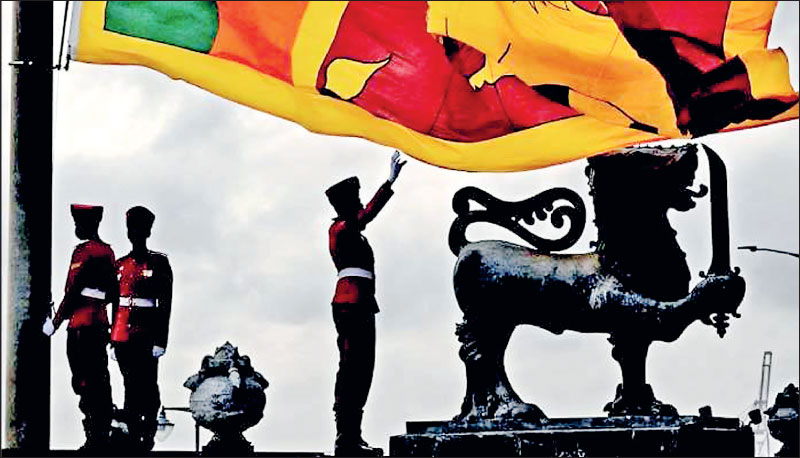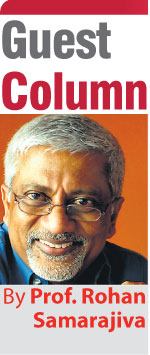Thursday Dec 18, 2025
Thursday Dec 18, 2025
Tuesday, 4 February 2025 00:16 - - {{hitsCtrl.values.hits}}

There is hope for us yet as we celebrate what has been achieved, mourn what could have been, and strive to do better
|
 Dr. Kapila Jayaratne, the President of the College of Community Physicians, called a news conference to talk about the life expectancy of Sri Lankans: 80 years for women and 76 for men. Back in 1945-47, men lived longer on average than women, to 46.8 years. Women had an average life expectancy of 44.7 years.
Dr. Kapila Jayaratne, the President of the College of Community Physicians, called a news conference to talk about the life expectancy of Sri Lankans: 80 years for women and 76 for men. Back in 1945-47, men lived longer on average than women, to 46.8 years. Women had an average life expectancy of 44.7 years.
Is this something to celebrate? It is indeed an achievement. Not attributable to a factor or two such as free healthcare or high literacy, but an aggregate indicator. Those of the “glass-half-full” persuasion will talk about rising cancer rates, lower quality of life for the pensionless poor (the majority), elder abuse by children, etc. but the point remains that we would not be even discussing such topics if most of us were in our graves before 50.
Thinking about the past 77 years
The conversation around life expectancy is a microcosm of the larger discourse about the post-independence period. The glass-half-full types and those who make it their business to point out problems that can only be solved by giving them power ignore the achievements and harp on the shortcomings.
A more productive path is to celebrate the achievements, but also work on the shortcomings. Be happy about life expectancy being within a few years of the numbers for the favoured migration destinations. But also focus on what can be done to improve the quality of life in those twilight years.
Similarly for the economy and society. Even after missing multiple opportunities and making many mistakes, we live better than we did just a few decades ago.
The food ratio (the percentage of household expenditure spent on food) is an excellent indicator of well being. When this started being calculated in the early 1990s, the average Sri Lankan household spent around two-thirds of total household income on food. By 2019, the last year with official data, it was 35.1%, indicating almost an inversion. Low is good with the food ratio, indicating people have more money left for health and beautycare and pilgrimages and entertainment. Of course, there was considerable variation: the lowest was Colombo District at 25.6% and the highest were Mullaitivu (57.5) and Batticaloa (55.3). Nuwara Eliya with a preponderance of those employed in estates came in at 50.1%. Unofficial survey data showed that the food ratio did not drastically change because of the crisis. People seemed to have cut food expenditure along with non-food expenditure.
Household assets are another indicator of how far we have come. In the immediate post-independence period sewing machines and bicycles were the most common household assets. According to the last Household Income and Expenditure Survey (HIES) 2019, more Sri Lankan homes had refrigerators (60.7%) than sewing machines (37.1). In the urban sector, more households had washing machines (46.6%) than sewing machines (44.2).
More than 60% of Sri Lankan households owned personal motor vehicles (two-wheeled 42.2%; three-wheeled 14.6; car/van 10.8). Bicycles were down at 28.9%. The HIES which was due in 2022 is much delayed, but surveys conducted in late 2022 and early 2023 showed that some household had been compelled to sell some assets.
This brings us to the cause of our recent despair, the economic crisis. And along with it the need to explain how life came back to normal, more or less, within two years.
Institutional failure and success
Consistent economic growth in the range of 7% may be observed in every country that has escaped the middle-income trap and reached high-income status. Sri Lanka’s growth has been the opposite of consistent. The ups and downs have been caused by the fixation on distributing goodies to those fortunate enough to get on the radar of the decision makers in Government (not always the poor), with no thought given to where the money was coming from. Politicians who declined to promise more freebies tended to be labelled as unelectable and rejected by their own parties.
The result was the failure to achieve primary surpluses (revenue exceeding expenditures, leaving aside debt repayments) in all but five years since independence. That meant that even recurrent expenditures tended to be based on debt and that almost all capital expenditures were undertaken with low-interest concessional loans in the early years and with high-interest commercial debt after 2007.
This was the root cause of the 2022-24 economic crisis. By that time, debt was being taken to service the prior debt. Viyath Maga tax cuts closed off access to commercial debt. When combined with massive monetary financing by the Central Bank the economy crashed, shortages became the norm and inflation skyrocketed. While individuals played villainous roles in this drama (for which responsibility has been assigned by the Supreme Court), the root causes are embedded in our political culture and institutions. Efforts to address these institutional weaknesses include, for example, the Central Bank Act, No. 16 of 2023 and the asset declaration provisions in the Anti-Corruption Act, No. 9 of 2023.
But without changes in political culture, laws by themselves cannot prevent more stagnation and periodic descent into crisis. Voters rewarding parties that made the most extravagant promises in the recent elections suggests there is more to be done, despite the learning opportunities offered by the crisis. While the crisis was extremely painful, especially for the near-poor who slid back into poverty and the businesses that went under, it could have been worse. Much worse. We could have ended up like Bangladesh with long hours without electricity after regime change, unlike our case where the shortages eased after the President was chased out. In Bangladesh, constitutional provisions were disregarded, the judiciary buckled and the legislature ceased to function.
In Sri Lanka, the formal and informal institutions held. Politicians explored constitutional options and respected the rulings of the Supreme Court. The police and the protestors respected the rulings of the magistrates. The business community, professional associations and citizen groups gave the protestors hope. When calls were made to take over parliament, the GotaGoGama protestors did not go. When hard but necessary measures were taken to stabilise the economy, the street did not erupt.
Over the past seven decades, our institutions have been weakened. But they did not buckle completely under unprecedented pressure. Even today, the Government’s proposals to strengthen party control of the State machinery is being met with resistance.
There is hope for us yet as we celebrate what has been achieved, mourn what could have been, and strive to do better.